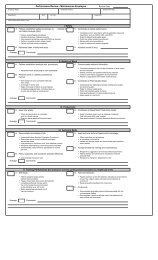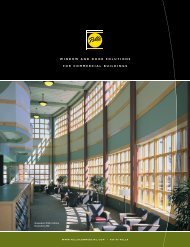Building Operating Management September 2011 - FacilitiesNet
Building Operating Management September 2011 - FacilitiesNet
Building Operating Management September 2011 - FacilitiesNet
You also want an ePaper? Increase the reach of your titles
YUMPU automatically turns print PDFs into web optimized ePapers that Google loves.
uildingoperatingmanagement<br />
SEPTEMBER <strong>2011</strong> 101<br />
While it’s certainly possible to replace<br />
one particular piece of an HVAC<br />
system and not touch the rest for 10<br />
years, it’s not likely. When considering<br />
upgrading one piece, take a look at everything<br />
else, as well.<br />
“You wouldn’t want to replace one<br />
piece and not consider the other pieces,”<br />
Ulrich says. “If you have a chiller<br />
that’s reaching the end of its useful life,<br />
you have to consider the condition of<br />
the cooling tower. It’s a mistake to replace<br />
the component of a system that<br />
has an obvious problem and not have<br />
the foresight to take a holistic look at it<br />
and say, ‘the chiller’s 30 years old and it<br />
has a problem, what else is that old?’”<br />
One good place to start when looking<br />
for other areas that might be affected<br />
by an upgrade is the control<br />
system. If you have a legacy control<br />
system, you’re running the risk of either<br />
limiting your upgrade options or<br />
not getting the most out of them.<br />
“I wouldn’t limit myself with an old<br />
BAS or energy management system and<br />
have that tail wag the dog, if you will,”<br />
Don’t just<br />
assume that a<br />
new piece will fit<br />
in the right spot<br />
— or be the right<br />
weight if it’s a<br />
rooftop unit<br />
Bamonte says. “I wouldn’t say, ‘since the<br />
controls can’t handle certain types of<br />
equipment, let’s not go down that road.’<br />
I would start with the main equipment<br />
and then work from there.”<br />
Other things to consider have more<br />
to do with the building’s infrastructure<br />
than anything else, such as ductwork<br />
and piping. And, Bamonte points out,<br />
don’t just assume that a new piece will<br />
fit in its intended spot — or be the<br />
right weight to be supported if it’s a<br />
rooftop unit.<br />
Codes play a part as well. With<br />
HVAC components having such long<br />
lifespans, codes can change multiple<br />
times from the time an HVAC product<br />
is installed until the time it is replaced.<br />
“Say I’ve got an A/C unit in the<br />
middle of a 20,000-square-foot floor,”<br />
says John Fallon, vice president of service<br />
for Donnelly Mechanical. “I want<br />
to change it, but now the code says I<br />
have to have fresh air going to it. It’s in<br />
the middle of a floor. How am I going<br />
to get fresh air to it?”<br />
There’s one other consideration before<br />
diving into upgrades, says Fallon.<br />
“If you’re going to be there five<br />
years or longer, then I would be looking<br />
at upgrading,” he says. Less than<br />
that, and stretching a system’s lifespan<br />
while repairing when needed becomes<br />
a more attractive option.<br />
The Human Element<br />
Regardless of how many parts of an<br />
HVAC system you’re going to replace,<br />
▲ FREE INFO: Circle 467 Booth #124





